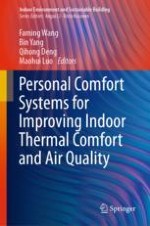2023 | OriginalPaper | Buchkapitel
Indoor Thermal Comfort Assessment Using Human Trials
verfasst von : Tze-Huan Lei, Li Lan, Faming Wang
Erschienen in: Personal Comfort Systems for Improving Indoor Thermal Comfort and Air Quality
Verlag: Springer Nature Singapore
Aktivieren Sie unsere intelligente Suche, um passende Fachinhalte oder Patente zu finden.
Wählen Sie Textabschnitte aus um mit Künstlicher Intelligenz passenden Patente zu finden. powered by
Markieren Sie Textabschnitte, um KI-gestützt weitere passende Inhalte zu finden. powered by
